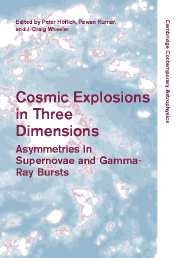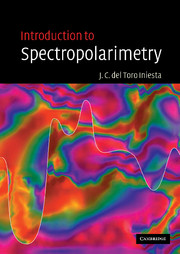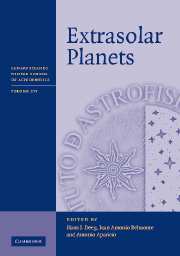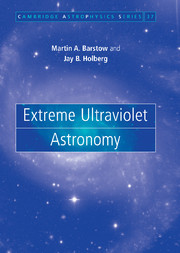Refine listing
Actions for selected content:
17000 results

Cosmic Explosions in Three Dimensions
- Asymmetries in Supernovae and Gamma-Ray Bursts
-
- Published online:
- 11 August 2009
- Print publication:
- 16 December 2004

Introduction to Spectropolarimetry
-
- Published online:
- 11 August 2009
- Print publication:
- 06 March 2003

Extrasolar Planets
-
- Published online:
- 10 August 2009
- Print publication:
- 18 October 2007

The Bigger Bang
-
- Published online:
- 10 August 2009
- Print publication:
- 02 May 2002

Extreme Ultraviolet Astronomy
-
- Published online:
- 07 August 2009
- Print publication:
- 13 March 2003

Meteorites, Ice, and Antarctica
- A Personal Account
-
- Published online:
- 06 August 2009
- Print publication:
- 10 July 2003
8 - The solar atmosphere
-
-
- Book:
- Heliophysics: Plasma Physics of the Local Cosmos
- Published online:
- 05 August 2013
- Print publication:
- 09 July 2009, pp 195-224
-
- Chapter
- Export citation
Appendix I - Authors and editors
-
- Book:
- Heliophysics: Plasma Physics of the Local Cosmos
- Published online:
- 05 August 2013
- Print publication:
- 09 July 2009, pp 399-400
-
- Chapter
- Export citation
10 - Fundamentals of planetary magnetospheres
-
-
- Book:
- Heliophysics: Plasma Physics of the Local Cosmos
- Published online:
- 05 August 2013
- Print publication:
- 09 July 2009, pp 256-294
-
- Chapter
- Export citation
Preface
-
- Book:
- Heliophysics: Plasma Physics of the Local Cosmos
- Published online:
- 05 August 2013
- Print publication:
- 09 July 2009, pp ix-x
-
- Chapter
- Export citation
List of tables
-
- Book:
- Heliophysics: Plasma Physics of the Local Cosmos
- Published online:
- 05 August 2013
- Print publication:
- 09 July 2009, pp 406-406
-
- Chapter
- Export citation
4 - Magnetic field topology
-
-
- Book:
- Heliophysics: Plasma Physics of the Local Cosmos
- Published online:
- 05 August 2013
- Print publication:
- 09 July 2009, pp 77-112
-
- Chapter
- Export citation
12 - On the ionosphere and chromosphere
-
-
- Book:
- Heliophysics: Plasma Physics of the Local Cosmos
- Published online:
- 05 August 2013
- Print publication:
- 09 July 2009, pp 324-359
-
- Chapter
- Export citation
9 - Stellar winds and magnetic fields
-
-
- Book:
- Heliophysics: Plasma Physics of the Local Cosmos
- Published online:
- 05 August 2013
- Print publication:
- 09 July 2009, pp 225-255
-
- Chapter
- Export citation
Index
-
- Book:
- Heliophysics: Plasma Physics of the Local Cosmos
- Published online:
- 05 August 2013
- Print publication:
- 09 July 2009, pp 428-435
-
- Chapter
- Export citation
7 - Turbulence in space plasmas
-
-
- Book:
- Heliophysics: Plasma Physics of the Local Cosmos
- Published online:
- 05 August 2013
- Print publication:
- 09 July 2009, pp 163-194
-
- Chapter
- Export citation
3 - Creation and destruction of magnetic field
-
-
- Book:
- Heliophysics: Plasma Physics of the Local Cosmos
- Published online:
- 05 August 2013
- Print publication:
- 09 July 2009, pp 42-76
-
- Chapter
- Export citation
1 - Prologue
-
-
- Book:
- Heliophysics: Plasma Physics of the Local Cosmos
- Published online:
- 05 August 2013
- Print publication:
- 09 July 2009, pp 1-20
-
- Chapter
- Export citation
11 - Solar-wind– magnetosphere coupling: an MHD perspective
-
-
- Book:
- Heliophysics: Plasma Physics of the Local Cosmos
- Published online:
- 05 August 2013
- Print publication:
- 09 July 2009, pp 295-323
-
- Chapter
- Export citation
13 - Comparative planetary environments
-
-
- Book:
- Heliophysics: Plasma Physics of the Local Cosmos
- Published online:
- 05 August 2013
- Print publication:
- 09 July 2009, pp 360-398
-
- Chapter
- Export citation
